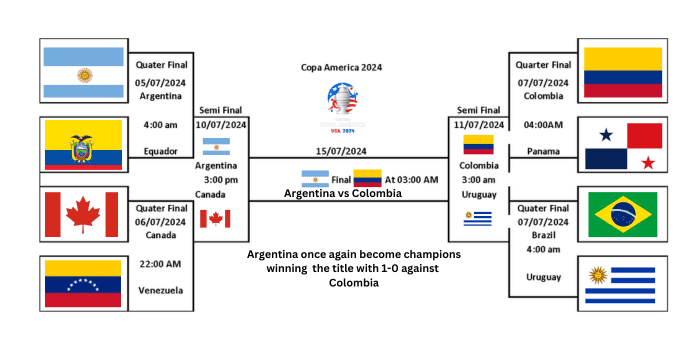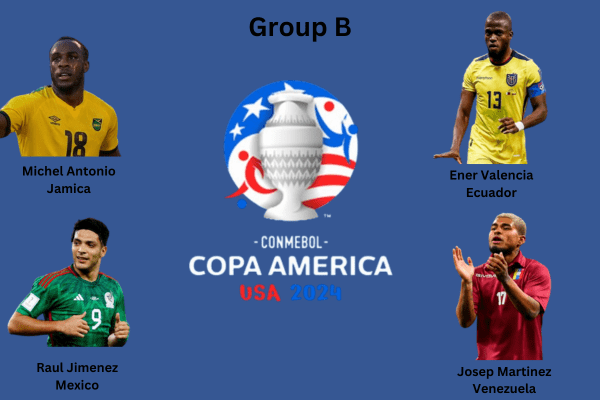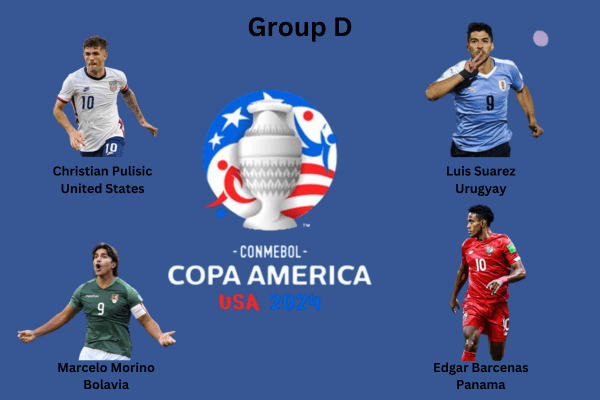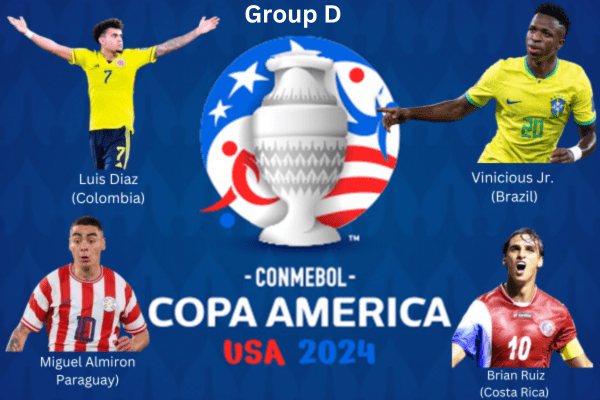The Crucible of Competition: A Breakdown of the 2024 Copa America Groups
The Copa America groups stage is divided into four groups, with four teams in each group. The teams play a round-robin format, where each team faces the other teams in their group once. The top two teams from each group advance to the knockout stage, along with the two best third-placed teams. The knockout rounds include quarterfinals, semifinals, and the final.
The 2024 Copa America, to be held in the United States, promises to be a summer full of exciting South American football alongside the talent of the CONCACAF challengers. The group stage serves as an enticing appetizer, offering a glimpse of team form, tactical nuances and potential upsets, before the knockout stages take center stage. Let’s explore each group in detail, analyzing the teams, their key figures and the stylistic tapestry they weave on the pitch.
Copa America Fixtures

Group A: A tango with tradition

Teams: Argentina (favorites), Chile (unexpected attackers), Peru (tactical underdogs), Canada (new underdogs)
Key players: Lionel Messi (Argentina) – a brilliant maestro who is gaining international fame in his final years, Alexis Sanchez (Chile) – an experienced attacker with a wealth of experience, Gianluca Lapadula (Peru) – a Mujahim, Attacker) reborn on the international stage, Alphonso Davies (Canada) – a dashing left-back who has the potential to make a splash in the tournament.
Playing Styles: Under the new coach, Argentina look to rekindle their attacking flair while maintaining defensive solidity. Chile remain an enigma even under the new manager, but their attacking style cannot be denied. Peru, known for its strategic astuteness, would prefer to suppress its opponents and exploit weaknesses. Canada, on their Copa America debut, offers a dose of youthful enthusiasm with a mix of European and MLS experience.
GROUP B: CONCACAF meets CONMEBOL

Teams: Mexico (established contenders), Ecuador (attack threat), Venezuela (reconstruction project), Jamaica (resilient underdogs)
Key players: Raul Jimenez (Mexico) – a clinical forward hungry for goals, Ener Valencia (Ecuador) – a powerhouse forward eager for spectacular performances, Josep Martínez (Venezuela) – a charismatic striker leading the rebuilding, Michael Antonio ( Jamaica) – A physical force who has the ability to cause problems for any defense.
Styles of play: Mexico, under a new manager, looks to combine their traditionally strong defense with a more dynamic attacking approach. Ecuador boast a possession-based style, inspired by Valencia’s attacking ability. Venezuela, under new leadership, is in a transitional phase, focusing on developing young talents and finding their strategic identity. Jamaica will use their physicality and counter-attacking tactics to frustrate their opponents.
Group C: Hometown heroes and familiar enemies

Teams: United States (hosts with a point to prove), Uruguay (seasoned veterans), Panama (well-trained underdogs), Bolivia (resilient high-altitude experts)
Key players: Christian Pulisic (United States) – a young winger who carries the country’s hopes, Luis Suarez (Uruguay) – a predatory goalscorer who is hungry for one last try, Edgar Bárcenas (Panama) – a creative The midfielder who is leading the charge for Panama is Marcelo Moreno (Bolivia) – an experienced striker who thrives in the thin air of high-altitude matches.
Styles of Play: The United States, under their experienced manager, will play an attacking brand of football, taking advantage of their home advantage and Pulisic’s attacking ability. Uruguay stuck to their tried and tested defensive approach coupled with Suarez’s attacking strikes. Known for its tenacious defense, Panama can be a thorn in the side of any team. Bolivia, accustomed to playing at high altitude, will adapt their style to the lower stadiums of the Americas, relying on their fighting spirit and Moreno’s experience.
Group D: A Dance of the Titans

Teams: Brazil (reigning champions), Colombia (exciting young talent), Paraguay (organized defence), Costa Rica (tournament veterans)
Key players: Vinicious Jr. (Brazil) – a dazzling playmaker with a lot to prove after a weak season, Luis Diaz (Colombia) – a rising star who aims to lead Colombia’s attack, Miguel Almiron (Paraguay) – solid defensively. Creative Spark Team, Brian Ruiz (Costa Rica) – An experienced leader guiding Costa Rica’s new generation of players.
Playing Styles: Brazil, under a new manager, looks to balance its inherent aggressive nature with a more pragmatic approach. Colombia, loaded with young talent like Diaz, plays aggressive football and tries to out-maneuver its opponents. Paraguay prefer a compact defensive formation, looking to hit on the counter with Almiron’s creativity. Costa Rica, known for its organized approach, utilizes experience under the guidance of the experienced Ruiz.
Predicting Favorites:
Based on current form and historical pedigree, Brazil and Argentina are the clear favorites in Groups B and A respectively. Group C is a toss-up, with the United States’ home advantage potentially giving them an edge over Uruguay’s experience. Group D offers an intriguing battle, with Brazil’s attacking prowess slightly outweighed by Colombia’s youthful enthusiasm.
Dark Horse Teams:
Don’t count Ecuador in Group B. Their aggressive capabilities can disrupt the established order. Similarly, Canada in Group A, with exciting young talent like Davis, has the potential to surprise. In Group C, Panama may face a tough challenge due to its defensive solidity.
Main matches:
The Argentina-Chile clash in Group A promises to be a spicy encounter, a clash of styles and historic rivalries. Between Mexico and Equador, football fans can expect fireworks on the pitch. In Group C, the United States and Uruguay will be in a battle between youthful enthusiasm and seasoned experience. Finally, Endrick attacking speed against Costa Rika in Group D will be worth watching.
Conclusion:
The group stage promises a captivating mix of strategic battles, individual brilliance and unexpected turns. While some teams enter as favourites, the underdog narrative is a constant thread in the Copa America tapestry. Buckle up and prepare to be thrilled by the inaugural event of this prestigious tournament, where South American talent meets CONCACAF grit, and new stars rise alongside established giants.
Answers to Common Questions
What is the Copa America?
How does it work?
When is it held?
Who are the stars?
Some of the biggest names in football will be playing in the Copa America, including Lionel Messi, Vinicious Jr., Luis Suarez, and Christian Pulisic.
